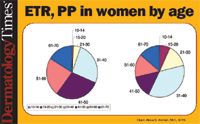- General Dermatology
- Eczema
- Chronic Hand Eczema
- Alopecia
- Aesthetics
- Vitiligo
- COVID-19
- Actinic Keratosis
- Precision Medicine and Biologics
- Rare Disease
- Wound Care
- Rosacea
- Psoriasis
- Psoriatic Arthritis
- Atopic Dermatitis
- Melasma
- NP and PA
- Skin Cancer
- Hidradenitis Suppurativa
- Drug Watch
- Pigmentary Disorders
- Acne
- Pediatric Dermatology
- Practice Management
- Prurigo Nodularis
Article
Rosacea prevalence underestimated
The age analyses also revealed the age of onset may be earlier for PP rosacea than for the ETR subtype.
National report - The prevalence of rosacea among Caucasian women appears to be higher than previously thought, according to the findings of a study undertaken by dermatology researchers at Harvard University, Boston.
The results were obtained from an investigation that included 850 females ages eight to 70 years old recruited from the general population in London and Los Angeles. With use of the National Rosacea Society Expert Committee standard classification system for rosacea subtypes to grade left-sided facial photographs, 174 (20.5 percent) of the 850 women were identified as having rosacea.
Prevalence underestimated

"However, most studies predate the availability of the Expert Committee criteria and base the diagnosis on self-report or poorly-defined signs and symptoms. We were interested in seeing what proportion of women would be diagnosed with rosacea using the standardized criteria published in 2002," Alexis C. Perkins, B.S., a Harvard Medical School student and Doris Duke Clinical Research Fellow, department of dermatology, Harvard Medical School, Boston, tells Dermatology Times.

The study participants were classified according to whether they had erythematotelangiectatic (ETR) or papulopustular (PP) rosacea and if they had ocular manifestations or phymatous changes. Of the 177 women with rosacea, 161 (92.6 percent) were considered to have ETR disease while only 13 (7.4 percent) had the PP subtype. Fourteen (8 percent) women had ocular involvement and seven (4 percent) had rhinophyma.

"Among women in the U.S. and U.K., rosacea prevalence is probably highest in the light-skinned Caucasian populations. However, we are now analyzing data collected in other, darker-skinned racial-ethnic groups and will be presenting those findings at a later date," Ms. Perkins notes.
Criteria from the Expert Committee were also used to grade the severity of PP and ETR rosacea in effected women. Fifty-three percent of the women with PP rosacea were considered to have mild disease, about one-third were rated as having moderate disease severity and 15 percent were considered to have severe disease. Mild disease was more common among women with ETR rosacea, affecting almost 75 percent of those individuals, while the skin disease severity was graded as moderate in 19 percent of the women with ETR rosacea and severe in 9 percent.





